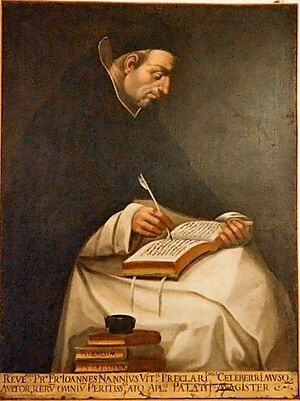Annius of Viterbo facts for kids
Quick facts for kids
Annius of Viterbo
|
|
|---|---|
 |
|
| Born | 5 January 1437 Viterbo, Papal States |
| Died | 13 November 1502 Rome, Papal States |
| Education | Magister Theologiae |
| Occupation | Archaeologist, historian, monk, literary forgery, orientalist |
| Works | Antiquitatum variarum volumina XVII |
Annius of Viterbo (born Giovanni Nanni) was an Italian scholar and historian. He was a Dominican friar, a type of monk, born in Viterbo on January 5, 1437. He is mainly remembered today for creating fake historical texts.
He joined the Dominican Order when he was young. He earned a degree in theology, which is the study of religious beliefs. He was highly respected by two popes, Sixtus IV and Alexander VI. Pope Alexander VI even made him the Master of the Sacred Palace in 1499. This was an important role in the Pope's household.
Annius claimed he was very good at Semitic languages, which are languages like Hebrew and Arabic. However, experts later found that his claims were not true. He also said he could read Etruscan, an ancient language from Italy.
In one of his most famous tricks, in 1493, he pretended to dig up ancient marble statues in Viterbo. These statues were supposed to be of mythical figures linked to the city's old legends. But in reality, Annius had secretly buried them there beforehand. This was a clever way to make people believe his stories.
Contents
Annius's Writings and Fake Discoveries
Annius of Viterbo is most famous for his book called Antiquitatum Variarum. This book was also known as the Antiquities of Annius. In it, he published what he claimed were writings and pieces from very old Greek and Latin authors. He said these texts would completely change what people knew about ancient history.
The Antiquities and Other Works
Annius claimed he found these important texts in Mantua, a city in Italy. However, it turned out that he had written all of them himself. These fake writings were meant to make it seem like Viterbo and the ancient Etruscan people were very important in early human history. He even made a map of ancient Rome based on his own made-up texts.
He wrote other books too. One was called De futuris Christianorum triumphis in Turcos et Saracenos. This title means Future Triumphs of the Christians over the Turks and the Saracens. In this book, he wrote about the future and predicted that Christians would win against the Turks and Saracens. He also wrote a book called Tractatus de imperio Turcorum (The Empire of the Turks).
Annius also wrote about the family tree of Jesus in the Gospel of Luke. He suggested that Jesus's family line went through his mother, Mary. He believed this showed that Jesus had a direct connection to King David through his mother's family.
Unpublished Writings
Annius had several other important writings that were never published during his lifetime. These included:
- Volumen libris septuaginta distinctum de antiquitatibus et gestis Etruscorum: This was about the history of the Etruscans.
- De dignitate officii Magistri Sacri Palatii: This discussed the importance of the Master of the Sacred Palace job.
- Chronologia Nova: In this work, he tried to correct mistakes in the timelines written by an ancient historian named Eusebius of Caesarea.
He also wrote De marmoreis volturrhenis tabulis, which was one of the first studies of ancient inscriptions in Western scholarship.
How His Forgeries Were Discovered
When Annius published his Antiquities, some people believed him right away. But others were suspicious and accused him of making things up. He claimed his texts were from famous ancient writers like Berosus and Cato the Elder.
Over time, it became clear that these "historians" he published were not real. They were all made up by Annius. A scholar named Joseph Justus Scaliger played a big part in showing that Annius's writings were fake.
By the mid-1500s, Annius's forgeries started to fall apart. For example, in 1565, a scholar named Girolamo Mei questioned Annius's work. Mei was arguing about whether Florence was founded by the Roman emperor Augustus. He showed that the evidence for this claim came from Annius's fake inscriptions. Mei proved that Annius's materials were not real.
Viterbiae historiae epitoma
A book published in 1981, called Annio da Viterbo, Documenti e ricerche, shared a previously unpublished work by Annius. This work was called Viterbiae historiae epitoma. It was the only remaining part of a larger history of Viterbo that Annius had written.
In this history, Annius wrote about the story of his hometown, Viterbo. He included its mythical beginnings, which he had invented himself. The book also explored Annius's interest in ancient myths and how his ideas influenced art in Viterbo, especially paintings with Egyptian images.
See Also
- Codex Nanianus

